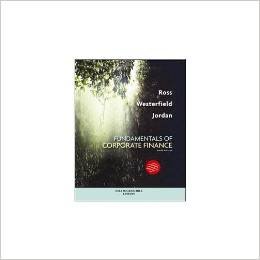
To discuss: On a project that does not have a positive
Introduction:
Net present value (NPV) refers to the current discounted value of the future cash flows. The company should accept the project, if the net present value is positive or greater than zero and vice-versa. If there are two mutually exclusive projects, then the company has to select the project that has higher net present value.
Answer to Problem 11.1CTF
The potential of believing that a particular project indicates a positive NPV when the project does not indicate a positive NPV is referred to as Negative NPV.
Explanation of Solution
The NPV of the project is the present value of all cash flows of a company’s project. In this form of cash flows, the
A particular project is accepted at the time when the project specifies a positive NPV. In case, a particular project does not point out a positive NPV, that particular project has to be rejected by the company.
Want to see more full solutions like this?
Chapter 11 Solutions
Fundamentals Of Corporate Finance, Tenth Standard Edition
- For the ORI to be truly optimal, it must maximize present worth over the planning horizon. True or false? Explain brarrow_forwardWhat is the criteria to accept a project based on the net present value and the internal rate of return?arrow_forwardwhat does it mean if the NPV and IRR are both positive, should the company invest on the project or not?arrow_forward
- How can you know whether a project will be profitable? What purpose does TCO serve?arrow_forward1. Compute the expected net present value and comment on the acceptability of the project considering the associated risk.arrow_forwardUnder what circumstances will you prefer profitability index to NPV as project evaluation techniques.arrow_forward
- Critically discuss the Expected Net Present Value method (ENPV) and explain why it may be more effective than the NPV method in valuing projects?arrow_forwardIn calculating the Net Present Value, the project would be acceptable if the outcome was: Group of answer choices Positive Positive or Zero Zero Negativearrow_forwardWhy is the net-investment test the only way to accurately predict projectborrowing? Explain with an example?arrow_forward
- Your firm is contemplating the purchase of a new $1,683,500 computer-based order entry system. The system will be depreciated straight-line to zero over its 5-year life. It will be worth $163,800 at the end of that time. You will be able to reduce working capital by $227,500 (this is a one-time reduction). The tax rate is 23 percent and your required return on the project is 17 percent and your pretax cost savings are $636,550 per year. a. What is the NPV of this project? NPV b. What is the NPV if the pretax cost savings are $458,300 per year? NPVarrow_forwardWhy are NPV, BCR, and IRR considered SUPERIOR indicators of Project Feasibility compared to Payback or Recoupment Period and Accounting Rates of Return? Explain briefly.arrow_forwardWhat is the process of economically evaluating a project's desirability?arrow_forward
